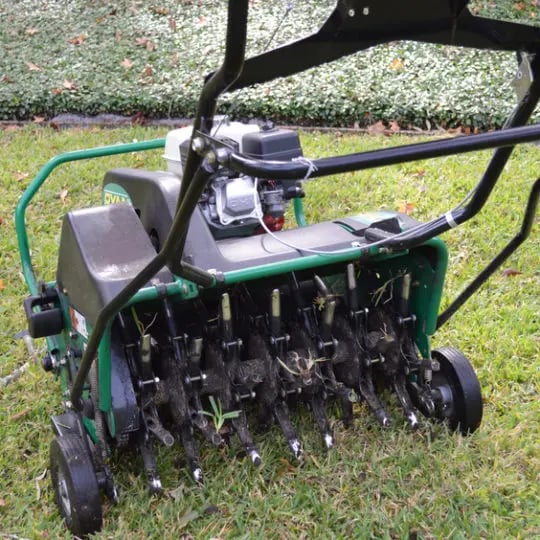Fall Lawn Aeration Tips

Every homeowner should know the importance of lawn aeration. A remedy for stressed lawns, aeration removes thatch (built-up grass and organic lawn matter) and loosens compacted soil to help encourage strong root development, aid in nutrient absorption, and create a healthier overall environment for your grass. The best time to aerate is in the fall when your lawn is at its strongest. Read on to learn some important tips about aerating your lawn this fall.
What is Aeration?
Aeration is the act of perforating your soil with small holes. Doing this allows your soil to absorb sun, water, air, and nutrients. This helps your turf develop a strong, healthy root system, resulting in a lush, green lawn.
Why Fall?
The fall is ideal for aeration because its cool air and warm soil temperatures prepare grass for the harsh conditions of winter. Aerating in the fall gives the soil access to sun, nutrients, and air, which helps prevent lawn diseases like snow mold from growing beneath the thatch. Aeration and the removal of thatch (dethatching) allows the roots of your grass to absorb these essential elements in order to develop strong, deep roots and ward off disease brought on by cold winters and excess thatch.
Thatch Patrol
Dethatching is another important aspect to lawn aeration. While small amounts of thatch can be fine, excessive amounts of this organic matter can weigh your grass down while suffocating the roots and preventing any vital elements from penetrating the surface of the soil. Try not to let thatch reach a thickness of more than ½” as more than this amount can encourage the presence of lawn diseases and insects. When used in conjunction with lawn aeration, dethatching can use small amounts of this thatch as plant food to encourage your lawn’s health as it biodegrades.
A Few Tips to Remember
- Watering the night before aeration can soften the soil. Avoid watering the day of to allow the soil time to absorb the water.
- Pay extra attention to any high-traffic areas that are frequently walked on. This is where soil tends to become the most compacted.
- Choose a core aerator with hollow tines that measure 4”L to 6”L.
- Know the basics of operating your aerator before use. Read its accompanying manual and familiarize yourself with its noise levels, tines, and how to start and stop and it.
Call Us
The friendly lawn-care professionals at Green Lawn Fertilizing are here year-round to help you properly aerate your PA, NJ or DE lawn. If you notice bare patches, puddles, or excess thatch, don’t hesitate to contact us today at 855-469-0692 for a free consultation to get your lawn on the road to recovery.
